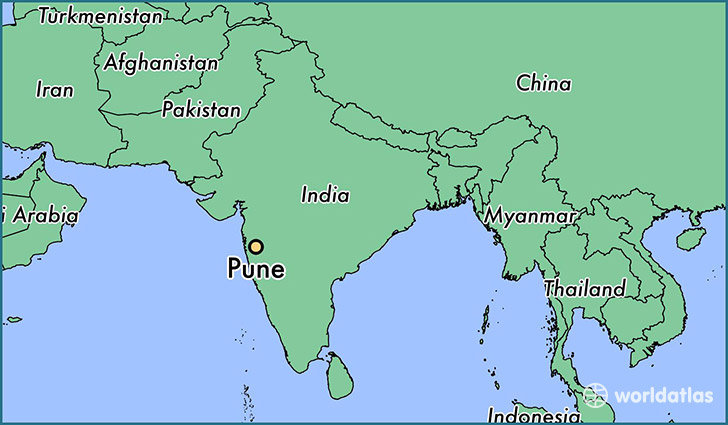Map of Pune- India

Pune is the second largest city in the Indian state of Maharashtra and the ninth most populous city in the country. Situated 560 metres (1,837 feet) above sea level on the Deccan plateau on the right bank of the Mutha river, Pune is the administrative headquarters of Pune district and was once the centre of power of the Maratha Empire established by Shivaji Maharaj. In the 18th century, Pune was the political centre of the Indian subcontinent, as the seat of the Peshwas who were the prime ministers of the Maratha Empire.
Considered to be the cultural capital of Maharashtra, Pune is known as “Oxford of the East” due to the presence of several well-known educational institutions in the city. The city has emerged as a major educational hub in recent decades, with nearly half of the total international students in the country studying in Pune. Since the 1950s and 1960s, Pune has had a traditional old-economic base as most of the old industries continue to grow. The city is known for its manufacturing and automobile industries, as well as for research institutes of information technology (IT), education, management and training, which attracts students, and professionals from India, South East Asia, the Middle East and Africa.
Pune is also one of the fastest growing cities in the Asia-Pacific region. The ‘Mercer 2015 Quality of Living rankings’ evaluated local living conditions in more than 440 cities around the world where Pune ranked at 145, second in India after Hyderabad (138). It also highlights Pune among evolving business centres and emerging nine cities around the world with citation “Hosts IT and automotive companies”.
Population
The population of the Pune city is 3,124,458 and Pune Urban Agglomeration (Pune Metropolitan Area) is 5,057,709 as of the 2011 census. The same was about 4,485,000 in 2005. The migrating population rose from 43,900 in 2001 to 88,200 in 2005. The estimated population in 2016 for the Pune metro region is 6,226,959. According to the Pune Municipal Corporation, 40{bef376110bfa03143d2876ae607e795619d5a101a3b0fc50948bd59761ffbbc0} of the population lived in slums in 2001. The sharp increase in censorial decade of 1991–2001 can be attributed to the absorption of 38 fringe villages into the city. The average literacy rate of Pune was 86.15 in 2011 compared to 80.45 in 2001. Marathi is the official and most widely spoken language, while English and Hindi are understood by a significant part of the population. Since Pune is a major industrial metropolis, it has attracted migrants from all parts of India to come and settle here. The top six areas of migration are Karnataka, Uttar Pradesh , Andhra Pradesh, Gujarat, and Rajasthan. The Sindhis in the city are mostly refugees and their descendants, who came to the area after the partition of India in 1947.
Language
Marathi is the official and most widely spoken language, while English and Hindi are understood by a significant part of the population.
Currency
Currency of Pune. The Indian rupee (Rs) is India’s currency, and comes in denominations of Rs1,000, 500, 100, 50, 20, 10 and 5 notes. Coins come in denominations of Rs5, 2 and 1, as well as 50 and 25 paise. There are 100 paise in a rupee.
Geography
Pune is 560 m (1,840 ft) above sea level on the western margin of the Deccan plateau. It is on the leeward side of the Sahyadri mountain range, which forms a barrier from the Arabian Sea. It is a hilly city, with its highest hill, Vetal Hill, rising to 800 m (2,600 ft) above sea level. Just outside the city, the Sinhagad fort is at an altitude of 1,300 metres (4,300 feet). It lies between 18° 32″ North latitude and 73° 51″ East longitude. Pune is 1,533 kilometres (953 mi) south of Delhi, 844 kilometres (524 mi) north of Bangalore, and 149 kilometres (93 mi) south-east of Mumbai by road.
Central Pune is at the confluence of the Mula and Mutha Rivers. The Pavana and Indrayani Rivers, tributaries of the Bhima River, traverse the northwestern outskirts of metropolitan Pune.
Climate
Pune has a hot semi-arid climate (BSh) bordering with tropical wet and dry (Aw) with average temperatures ranging between 19 to 33 °C (66 to 91 °F).Pune experiences three seasons: summer, monsoon, and winter. Typical summer months are from March to June often extending till 15 June, with maximum temperatures sometimes reaching 42 °C (108 °F). The warmest month in Pune is between 20 April and 20 May; although summer doesn’t end until May, the city often receives heavy dusty winds in May (and humidity remains high). Even during the hottest months, the nights are usually cool due to Pune’s high altitude. The highest temperature ever recorded was 43.3 °C (109.9 °F) on 30 April 1897.
The monsoon lasts from June to October, with moderate rainfall and temperatures ranging from 22 to 28 °C (72 to 82 °F). Most of the 722 mm (28.43 in) of annual rainfall in the city falls between June and September, and July is the wettest month of the year. Hailstorms are not unheard of in this region.
Winter traditionally begins in November; November in particular is referred to as the Rosy Cold (literal translation) (Marathi: गुलाबी थंडी) which can be experienced typically during the festive season of Diwali. The daytime temperature hovers around 26 °C (79 °F) while night temperature is below 9 °C (48 °F) for most of December and January, often dropping to 5 to 6 °C (41 to 43 °F). The lowest temperature ever recorded was 1.7 °C (35 °F) on 17 January 1935. The climate of Pune has changed during the past 3 decades, especially since the rapid expansion of the industrial belts.
Religion
Hinduism is the dominant religion in Pune. Many Churches, Mosque, Gurudwaras, Buddhist Viharas, Jewish synagogues, Jain temples, and other religious buildings are found throughout the city. Major communities by religion include Hindus, Muslims, Sikhs, Jains, Buddhists, and Christians. The most prominent Hindu temple in Pune is the Parvati Temple, located on Parvati hill and visible from most of the inner suburbs. The most visited temple is likely the Dagadusheth Halwai Ganapati temple, located in old city area of Pune. Also a popular temple is the Chaturshrungi Temple, located on Senapati Bapat road in the north west area of Pune. During Navratri, there is a large fair at the temple and worshippers gather from around the country to pray here. The presiding Deity of the city is the Kasba Ganapati this temple has be first redeveloped by Rajmata Jijau, whose temple is located in Kasba Peth in central Pune. Sarasbaug Ganpati is also a prominent landmark in Pune.
Islam is the second largest religion in Pune. Pune has a large number of Mosques, the most prominent of which are Chand Tara Masjid, Jaama Masjid, and Azam Campus Masjid. Chand Tara Masjid, located in Nana Peth, is one of the biggest and most important mosques in Pune as it is the city headquarters (markaz) for the Tablighi Jamaat. The Eid-gah Maidan located near Golibar Maidan on Shankar Sheth Road witnesses a large gathering of people for Eid namaz on Eid al-Fitr and Eid al-Adha.
Pune has over 20 Gurdwaras. Gurdwara Guru Nanak Darbar,Camp and Gurdwara Shri Guru Singh Sabha, Ganesh Peth being the ones situated in the heart of the city. Sikhism is one of the major religions of Pune and Sikhs have become an integral part of the society.In the past a Sikh has been elected mayor of Pune. The community also runs 2 schools.The Sikh community in Pune celebrates Gurpurabs with a lot of enthusiasm. They also organise Kirtan Darbars yearly which are attended by many important religious figures of the Sikh community as well as other communities. They serve Langar to all irrespective of the caste, creed or race of a person.
Other important religious places of other religions in Pune are the Ohel David Synagogue, The St Peter’s Cathedral, Dapodi Church, JJ Agiary.
The Shrutisagar Ashram, located at Phulgaon off the Nagar road, houses the Vedanta Research Centre and a unique temple of Dakshinamurthy, located near the confluence of the Bhima, Bhama, and Indrayani rivers. It was established in 1989 by Swami Swaroopanand Saraswati. Here one can find detailed explanations of śruti and smriti (including the Vedas, Bhagavad Gita, Upanishads and Puranas) in Marathi and English. As of the 2011 census, the population of Pune is as follows.
Culture
Pune is said to be the cultural capital of the state of Maharashtra. It epitomises Marathi culture, which places emphasis on education, arts and crafts, music, and theatre. Pune culture reflects a blend of traditions with modernity, along with hosting classical shows.
Auditoriums like the Balgandharva Ranga Mandir, Tilak Smarak Mandir and the Yashwantrao Chavan Natyagruha have been at the service of Punekars and are famous for playing host too many commercial theatre acts. Smaller auditorims like the Sudarshan Rangamanch and Bharat Natya Sanshodhan Mandir are the favourite places for many intercollegiate competitions and also are the focal point of the city’s experimental and amateur theatre movement.
Pune hosts the most prestigious festival for Hindusthani classical music, viz. Sawai Gandharva Bhimsen Mahotsav (Populerly known as ‘Sawai’). Besides ‘Sawai’, many festivals like Swarazankar, Vasantotsav are organized in Pune.
Cuisine
Sorghum and Pearl millet are the main ingredients of traditional Pune food. Specialties include Misal Pav, Puran Poli (a dessert bread), Pithla bhakri, Panipuri, Bhelpuri, and Pav Bhaji. Mastani, a thick milkshake containing dried fruit, is a speciality of the city. Another speciality is Bakarvadi, a crispy snack item. Vada Pav, Misal Pav, Poha, Dabeli, and Bhelpuri are popular street food items. Being a Metropolitan city, Pune also boasts a wide variety of restaurants, serving cuisines from all over the world.
Transport
Air
Pune International Airport is an international Airport at Lohegaon, operated by the Airports Authority of India. It shares its runways with the neighbouring Indian Air Force base. In addition to domestic flights to all major Indian cities, this airport serves international direct flights to Dubai (operated by Air India Express) and to Frankfurt (operated by Lufthansa).
The Maharashtra Industrial Development Corporation is responsible for the design and construction of a New Pune International Airport. The area between Chakan and Rajgurunagar, around the villages of Chandus and Shiroli, is being considered as a construction site. If constructed here, it will be at a distance of 40 km (25 mi) from central Pune. With the construction of this new International Airport, Pune city will be connected to many important international destinations such as London, New York, Singapore, Hong Kong and Tokyo. They have passed tender for Pune International Airport at Chakan Pune. This project will be complete by December 2017.
Rail
Local trains (EMUs) connect Pune to the industrial town of Pimpri-Chinchwad and the hill station of Lonavala, while daily express trains connect Pune to Mumbai, Hyderabad, Delhi, Nagpur, Thiruvananthapuram, Kochi, Coimbatore, Chennai, Bangalore, Allahabad, Kanpur, Howrah, Jammu Tawi, Darbhanga, Goa, Gwalior, Varanasi, Bhubaneswar, Patna, and Jamshedpur. At Pune, there is a diesel locomotive shed and an electric trip shed.
The Pune Railway Station is administered by the Pune Railway Division of the Central Railways. All the railway lines to Pune are broad gauge. The city also has a Motive power depot located at Ghorpadi. It is operated for Diesel Locomotives.
Metro
A mass transit system called Pune Metro has been proposed for the city. and is being planned in consultation with Delhi Metro Rail Corporation Limited, the corporation which built and operates the Delhi Metro. It will be a combination of elevated and underground sections, with initial routes being planned between Pimpri-Swargate and Vanaz-Ramwadi. However, construction of the socalled “Pune Metro” has not been heard of as of May 2016. Also, Pune Metro will not be having services like that of Mumbai Metro has.
Roads
Both public and private transport are popular in Pune. Public buses within the city and its suburbs are operated by the Pune Mahanagar Parivahan Mahamandal Limited (PMPML). The PMPML operates the Rainbow BRTS system, the first of its kind in India, in which dedicated bus lanes were supposed to allow buses to travel quickly through the city. In reality the project has turned out to be a failure, receiving little to no patronage from the local citizenry. Maharashtra State Road Transport Corporation runs buses from its main stations in Shivajinagar, Pune station, and Swargate to all major cities and towns in Maharashtra and neighbouring states. Private companies also run buses to major cities throughout India.
Pune is well-connected to other cities by Indian highways and state highways. National Highway 4 (NH 4) connects it to Mumbai, Bangalore and Kolhapur. NH 9 to Hyderabad, and NH 50 to Nashik. State highways connect it to Ahmednagar, Aurangabad, and Alandi.
The Mumbai-Pune Expressway is India’s first six-lane high-speed expressway, and it was built in 2002. This expressway has reduced travel time between Pune and Mumbai to almost two hours. A ring road is being planned for the convenience of heavy traffic. On the express highway only four wheelers are allowed, thus only private cars, buses and taxis can travel on this route.
Pune is served by two intra-city highways: Old Pune-Mumbai Highway and Katraj-Dehu Road Bypass, a part of National Highway 4. The Nashik City-Pune Highway NH 50 will be part of the golden triangle (Nashik-Pune-Mumbai).










